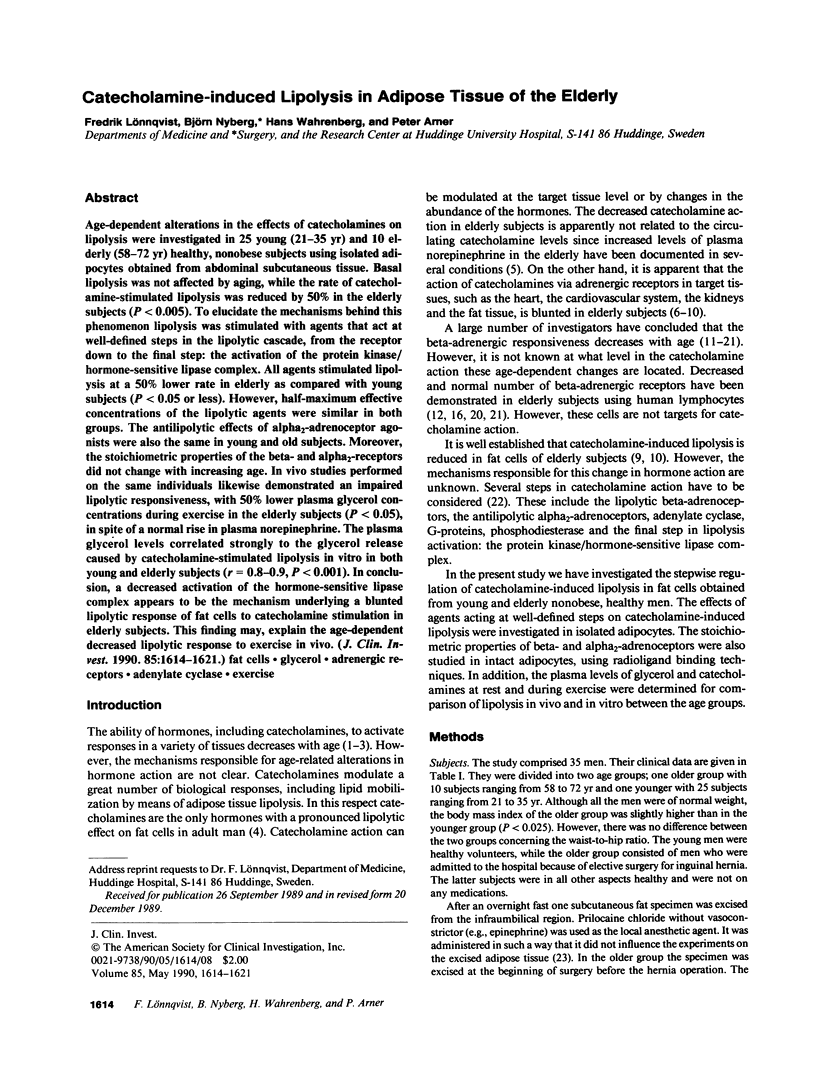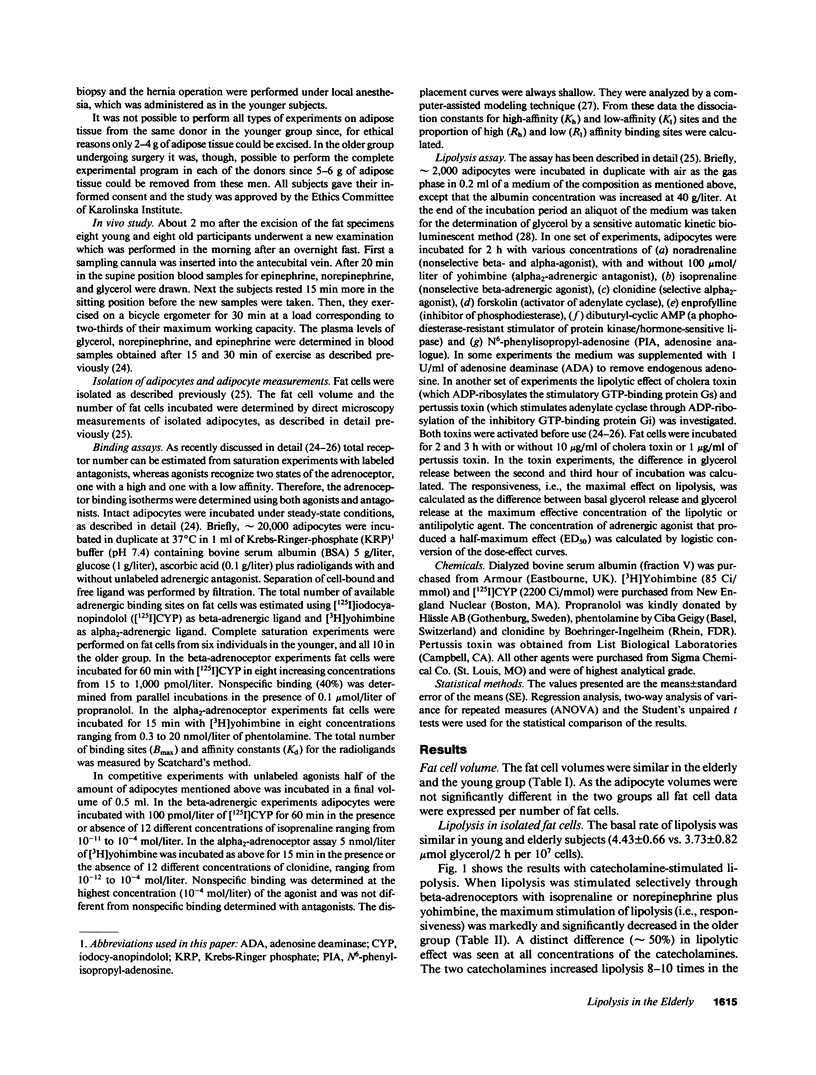Abstract
Age-dependent alterations in the effects of catecholamines on lipolysis were investigated in 25 young (21-35 yr) and 10 elderly (58-72 yr) healthy, nonobese subjects using isolated adipocytes obtained from abdominal subcutaneous tissue. Basal lipolysis was not affected by aging, while the rate of catecholamine-stimulated lipolysis was reduced by 50% in the elderly subjects (P less than 0.005). To elucidate the mechanisms behind this phenomenon lipolysis was stimulated with agents that act at well-defined steps in the lipolytic cascade, from the receptor down to the final step: the activation of the protein kinase/hormone-sensitive lipase complex. All agents stimulated lipolysis at a 50% lower rate in elderly as compared with young subjects (P less than 0.05 or less). However, half-maximum effective concentrations of the lipolytic agents were similar in both groups. The antilipolytic effects of alpha 2-adrenoceptor agonists were also the same in young and old subjects. Moreover, the stoichiometric properties of the beta- and alpha 2-receptors did not change with increasing age. In vivo studies performed on the same individuals likewise demonstrated an impaired lipolytic responsiveness, with 50% lower plasma glycerol concentrations during exercise in the elderly subjects (P less than 0.05), in spite of a normal rise in plasma norepinephrine. The plasma glycerol levels correlated strongly to the glycerol release caused by catecholamine-stimulated lipolysis in vitro in both young and elderly subjects (r = 0.8-0.9, P less than 0.001). In conclusion, a decreased activation of the hormone-sensitive lipase complex appears to be the mechanism underlying a blunted lipolytic response of fat cells to catecholamine stimulation in elderly subjects. This finding may, explain the age-dependent decreased lipolytic response to exercise in vivo.
Full text
PDF







Selected References
These references are in PubMed. This may not be the complete list of references from this article.
- Abrass I. B., Davis J. L., Scarpace P. J. Isoproterenol responsiveness and myocardial beta-adrenergic receptors in young and old rats. J Gerontol. 1982 Mar;37(2):156–160. doi: 10.1093/geronj/37.2.156. [DOI] [PubMed] [Google Scholar]
- Abrass I. B., Scarpace P. J. Catalytic unit of adenylate cyclase: reduced activity in aged-human lymphocytes. J Clin Endocrinol Metab. 1982 Nov;55(5):1026–1028. doi: 10.1210/jcem-55-5-1026. [DOI] [PubMed] [Google Scholar]
- Abrass I. B., Scarpace P. J. Human lymphocyte beta-adrenergic receptors are unaltered with age. J Gerontol. 1981 May;36(3):298–301. doi: 10.1093/geronj/36.3.298. [DOI] [PubMed] [Google Scholar]
- Arner P., Arner O., Ostman J. The effect of local anaesthetic agents on lipolysis by human adipose tissue. Life Sci. 1973 Jul 16;13(2):161–169. doi: 10.1016/0024-3205(73)90191-4. [DOI] [PubMed] [Google Scholar]
- Arner P. Control of lipolysis and its relevance to development of obesity in man. Diabetes Metab Rev. 1988 Aug;4(5):507–515. [PubMed] [Google Scholar]
- BURNS T. W., GEHRKE C. W., ANIGIAN M. J., LANGLEY P. E. EFFECT OF INSULIN ON PLASMA FREE FATTY ACIDS OF NORMAL SUBJECTS. J Lab Clin Med. 1963 Oct;62:646–656. [PubMed] [Google Scholar]
- Bolinder J., Ostman J., Arner P. Influence of aging on insulin receptor binding and metabolic effects of insulin on human adipose tissue. Diabetes. 1983 Oct;32(10):959–964. doi: 10.2337/diab.32.10.959. [DOI] [PubMed] [Google Scholar]
- Bühler F. R., Kiowski W., van Brummelen P., Amann F. W., Bertel O., Landmann R., Lütold B. E., Bolli P. Plasma catecholamines and cardiac, renal and peripheral vascular adrenoceptor-mediated responses in different age groups of normal and hypertensive subjects. Clin Exp Hypertens. 1980;2(3-4):409–426. doi: 10.3109/10641968009037122. [DOI] [PubMed] [Google Scholar]
- Cooper B., Gregerman R. I. Hormone-sensitive fat cell adenylate cyclase in the rat. Influences of growth, cell size, and aging. J Clin Invest. 1976 Jan;57(1):161–168. doi: 10.1172/JCI108256. [DOI] [PMC free article] [PubMed] [Google Scholar]
- Cutler N. R., Hodes J. E. Assessing the noradrenergic system in normal aging: a review of methodology. Exp Aging Res. 1983 Fall;9(3):123–127. doi: 10.1080/03610738308258439. [DOI] [PubMed] [Google Scholar]
- Dax E. M., Partilla J. S., Gregerman R. I. Mechanism of the age-related decrease of epinephrine-stimulated lipolysis in isolated rat adipocytes: beta-adrenergic receptor binding, adenylate cyclase activity, and cyclic AMP accumulation. J Lipid Res. 1981 Aug;22(6):934–943. [PubMed] [Google Scholar]
- Dillon N., Chung S., Kelly J., O'Malley K. Age and beta adrenoceptor-mediated function. Clin Pharmacol Ther. 1980 Jun;27(6):769–772. doi: 10.1038/clpt.1980.108. [DOI] [PubMed] [Google Scholar]
- Doyle V., O'Malley K., Kelly J. G. Human lymphocyte beta-adrenoceptor density in relation to age and hypertension. J Cardiovasc Pharmacol. 1982 Sep-Oct;4(5):738–740. doi: 10.1097/00005344-198209000-00007. [DOI] [PubMed] [Google Scholar]
- Fain J. N., Garcĩa-Sáinz J. A. Adrenergic regulation of adipocyte metabolism. J Lipid Res. 1983 Aug;24(8):945–966. [PubMed] [Google Scholar]
- Feldman R. D., Limbird L. E., Nadeau J., Robertson D., Wood A. J. Alterations in leukocyte beta-receptor affinity with aging. A potential explanation for altered beta-adrenergic sensitivity in the elderly. N Engl J Med. 1984 Mar 29;310(13):815–819. doi: 10.1056/NEJM198403293101303. [DOI] [PubMed] [Google Scholar]
- Forn J., Schonhofer P. S., Skidmore I. F., Krishna G. Effect of aging on the adenyl cyclase and phosphodiesterase activity of isolated fat cells of rat. Biochim Biophys Acta. 1970 May 12;208(2):304–309. doi: 10.1016/0304-4165(70)90249-7. [DOI] [PubMed] [Google Scholar]
- Giudicelli Y., Pecquery R. beta-Adrenergic receptors and catecholamine-sensitive adenylate cyclase in rat fat-cell membranes: influence of growth, cell size and aging. Eur J Biochem. 1978 Oct;90(2):413–419. doi: 10.1111/j.1432-1033.1978.tb12619.x. [DOI] [PubMed] [Google Scholar]
- Hellmér J., Arner P., Lundin A. Automatic luminometric kinetic assay of glycerol for lipolysis studies. Anal Biochem. 1989 Feb 15;177(1):132–137. doi: 10.1016/0003-2697(89)90027-4. [DOI] [PubMed] [Google Scholar]
- Hoffman B. B., Chang H., Farahbakhsh Z., Reaven G. Inhibition of lipolysis by adenosine is potentiated with age. J Clin Invest. 1984 Nov;74(5):1750–1755. doi: 10.1172/JCI111593. [DOI] [PMC free article] [PubMed] [Google Scholar]
- Hoffman B. B., Chang H., Reaven G. M. Stimulation and inhibition of lipolysis in isolated rat adipocytes: evidence for age-related changes in responses to forskolin and PGE1. Horm Metab Res. 1987 Aug;19(8):358–360. doi: 10.1055/s-2007-1011823. [DOI] [PubMed] [Google Scholar]
- James R. C., Burns T. W., Chase G. R. Lipolysis of human adipose tissue cells: influence of donor factors. J Lab Clin Med. 1971 Feb;77(2):254–266. [PubMed] [Google Scholar]
- Kelly J., O'Malley K. Adrenoceptor function and ageing. Clin Sci (Lond) 1984 May;66(5):509–515. doi: 10.1042/cs0660509. [DOI] [PubMed] [Google Scholar]
- Krall J. F., Connelly M., Weisbart R., Tuck M. L. Age-related elevation of plasma catecholamine concentration and reduced responsiveness of lymphocyte adenylate cyclase. J Clin Endocrinol Metab. 1981 May;52(5):863–867. doi: 10.1210/jcem-52-5-863. [DOI] [PubMed] [Google Scholar]
- Lakatta E. G., Gerstenblith G., Angell C. S., Shock N. W., Weisfeldt M. L. Diminished inotropic response of aged myocardium to catecholamines. Circ Res. 1975 Feb;36(2):262–269. doi: 10.1161/01.res.36.2.262. [DOI] [PubMed] [Google Scholar]
- Marcus C., Ehrén H., Bolme P., Arner P. Regulation of lipolysis during the neonatal period. Importance of thyrotropin. J Clin Invest. 1988 Nov;82(5):1793–1797. doi: 10.1172/JCI113793. [DOI] [PMC free article] [PubMed] [Google Scholar]
- Marcus C., Karpe B., Bolme P., Sonnenfeld T., Arner P. Changes in catecholamine-induced lipolysis in isolated human fat cells during the first year of life. J Clin Invest. 1987 Jun;79(6):1812–1818. doi: 10.1172/JCI113022. [DOI] [PMC free article] [PubMed] [Google Scholar]
- Munson P. J., Rodbard D. Ligand: a versatile computerized approach for characterization of ligand-binding systems. Anal Biochem. 1980 Sep 1;107(1):220–239. doi: 10.1016/0003-2697(80)90515-1. [DOI] [PubMed] [Google Scholar]
- Ostman J., Efendić S., Arner P. Catecholamines and metabolism of human adipose tissue. I. Comparison between in vitro effects of noradrenaline, adrenaline and theophylline on lipolysis in omental adipose tissue. Acta Med Scand. 1969 Oct;186(4):241–246. [PubMed] [Google Scholar]
- Pfeifer M. A., Weinberg C. R., Cook D., Best J. D., Reenan A., Halter J. B. Differential changes of autonomic nervous system function with age in man. Am J Med. 1983 Aug;75(2):249–258. doi: 10.1016/0002-9343(83)91201-9. [DOI] [PubMed] [Google Scholar]
- Roth G. S. Hormone action during aging: alterations and mechanisms. Mech Ageing Dev. 1979 Mar;9(5-6):497–514. doi: 10.1016/0047-6374(79)90090-3. [DOI] [PubMed] [Google Scholar]
- Schocken D. D., Roth G. S. Reduced beta-adrenergic receptor concentrations in ageing man. Nature. 1977 Jun 30;267(5614):856–858. doi: 10.1038/267856a0. [DOI] [PubMed] [Google Scholar]
- Vestal R. E., Wood A. J., Shand D. G. Reduced beta-adrenoceptor sensitivity in the elderly. Clin Pharmacol Ther. 1979 Aug;26(2):181–186. doi: 10.1002/cpt1979262181. [DOI] [PubMed] [Google Scholar]
- Wahrenberg H., Engfeldt P., Bolinder J., Arner P. Acute adaptation in adrenergic control of lipolysis during physical exercise in humans. Am J Physiol. 1987 Oct;253(4 Pt 1):E383–E390. doi: 10.1152/ajpendo.1987.253.4.E383. [DOI] [PubMed] [Google Scholar]
- Wahrenberg H., Lönnqvist F., Arner P. Mechanisms underlying regional differences in lipolysis in human adipose tissue. J Clin Invest. 1989 Aug;84(2):458–467. doi: 10.1172/JCI114187. [DOI] [PMC free article] [PubMed] [Google Scholar]
- Wahrenberg H., Lönnqvist F., Engfeldt P., Arner P. Abnormal action of catecholamines on lipolysis in adipocytes of type I diabetic patients treated with insulin. Diabetes. 1989 Apr;38(4):524–533. doi: 10.2337/diab.38.4.524. [DOI] [PubMed] [Google Scholar]


